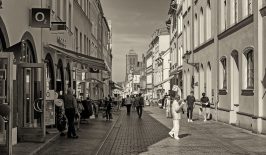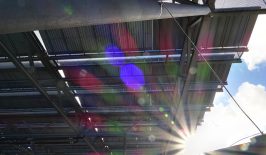A road surface that generates electricity from sunlight, absorbs noise, breaks down nitrogen oxides, defrosts ice in winter, provides valuable data and supplies electric vehicles with electricity. Sound too good to be true? It’s true, and it’s here. The “Voltstreet” concept developed by our partner project Solmove has already won numerous awards and is set to be installed on a cycle path near Cologne, Germany, this October.
The original solar street idea was born in the Allgäu, in Bavaria. Donald Müller-Judex, founder of the company, had spent three days driving around the area looking for an empty roof to install solar panels on. But all the roofs he found were already covered with panels. Something else, however, was empty and catching the sun’s rays: the many roads he was driving down. That was where the idea was born – the idea of using all that unitilised “horizontal” potential and transforming it into smart roads. Using roads not just for traffic but also as a source of solar power would make it possible to produce enough clean electricity to power 20 million EVs – without taking up any extra land. That was the first calculation. But solar roads could do even more: not just supply EVs with electricity, but also with data too. While at the same time making sure driving on them is quiet, clean and comfortable.
The Solmove company was founded in 2014. In a research alliance with two Fraunhofer Institutes, two universities and other experts, the original solar street concept was developed into a multifunctional “solar carpet” containing photovoltaic cells, LEDs and sensors. The system is easily electrically connected – the modules are simply clicked together – and can then be glued to existing surfaces such as roads and paths. The electricity generated is fed into the grid or used right there on the spot. In the future, electric vehicles will be able to “suck” the electricity out of the street via induction (similarly to the already-proven system of wirelessly charging cars when parked). The Solmove road surface also has noise reduction properties and offers both lighting and heating. And sustainability is key: the modules are robust enough to last an estimated 20-25 years, and their later removal has been thought about too – the surface can be milled away just like conventional asphalt, and 95 per cent of the granulate is recyclable.
3S – Smart Solar Street Platform
Solmove’s multifunctional surface is set to turn the road network into a power network, and – in another first – also a data network. The integrated sensor technology will make the road “feel” what’s going on around it – obtaining real-time data about vehicle positions, and cleverly optimising the flow of traffic and controlling the traffic lights.
In addition to all this, Solmove is developing a platform where different providers can offer services. The 3S (Smart Solar Street) platform will be used to connect utilities, charging infrastructure operators, big data applications, traffic control, fleet management, car park owners and payment service providers, among others. That could, for example, make it possible for a shop to book cargo bikes using the platform or for a battery supplier for EV charging stations to monitor their stations and manage their customers via the 3S system.
Biking down the “Solar Street”
Production of the solar modules began in August 2018: “For the first time, Solmove’s glass modules are coming off the production line – perfectly-sized and by the ton. We have been working on this for two years and are delighted to now have enough glass for the first solar cycle path and for other projects. If everything goes well, then the Federal Minister for the Environment will open the cycle path near Cologne in October,” said Müller-Judex.
The cycle path near Cologne will be 90 metres long and is partly financed by the Federal Ministry for the Environment (BMU). The official opening is very soon.
It’s the journey, not the destination
Solmove is currently receiving more requests for its smart solar street system than they are able to handle. And not without reason: alongside its many other selling points, the solar surface seems to pay off. According to Solmove, while a conventional road has annual costs of one euro per square metre, a solar road can actually earn money, with the current yield approximately 3 to 5 euro per square metre annually.
The team behind Solmove has big plans: “Success for us will be converting hundreds of kilometres of road into power stations, thereby saving thousands of tons of CO2, having millions of humans travel across it sustainably in their EVs and making billions of US dollars of crude oil purchases redundant. It would be ideal if 190 countries in the world could be made energy-autonomous thanks to solar roads – removing at least one of the main reasons for war in the world,” says Donald Müller-Judex.
Other countries are also working on solar roads, including SolaRoad (Netherlands), Wattway (France), Platio (Hungary), Solar Roadways (USA) and Pavenergy (China). What distinguishes Solmove is its smart multifunctionality and fast installation. All suppliers, just like Solmove, are at the beginning of a development process that will continue for years. It will be particularly interesting to see how the roads hold up under long-term use and pressure.
RESET has been supporting Solmove on its way to successful financing and to a sustainable business model within the framework of Green Impact Finance. We’re really happy to see that we’re off to a good start!
If you would like to contribute to the further development of solar streets: Solmove is currently looking for a software architect. Information (in German) about the job can be found here.
This is a translation by Marisa Pettit of an original article that first appeared on RESET’s German-language site.





